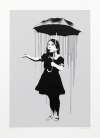No
Ball Games
Banksy's humorous No Ball Games depicts two children throwing a sign with the titular words. Released as part of the Pictures on Walls Christmas show, “Fiesta Resistance,” the image has non-conformity at its core, urging viewers to question societal norms and find rebellious loopholes like the children.
Banksy No Ball Games For sale
No Ball Games Value (5 Years)
Works from the No Ball Games series by Banksy have a strong market value presence, with 55 auction appearances. Top performing works have achieved standout auction results, with peak hammer prices of £85352. Over the past 12 months, average values across the series have ranged from £20000 to £31000. The series shows an average annual growth rate of 17.89%.
No Ball Games Market value
Auction Results
| Artwork | Auction Date | Auction House | Return to Seller | Hammer Price | Buyer Paid |
|---|---|---|---|---|---|
 No Ball Games (green) Banksy Signed Print | 15 Apr 2025 | Sotheby's New York | £17,850 | £21,000 | £29,000 |
 No Ball Games (grey) Banksy Signed Print | 30 Nov 2023 | Koller Geneva | £29,750 | £35,000 | £45,000 |
Sell Your Art
with Us
with Us
Join Our Network of Collectors. Buy, Sell and Track Demand
Meaning & Analysis
Originally painted as a mural in Tottenham, North London, Banksy’s No Ball Games shows two children playing catch with a bright red sign.
In 2009, Banksy released No Ball Games in an edition of 250 signed green and 250 signed grey prints. This release was part of the Pictures on Walls Christmas show, "Fiesta Resistance". The green version of No Ball Games was released online via the printer's website, while the grey version was available to buy from their in-person store. Collectors queued up in temperatures as low as -7°C in order to buy No Ball Games (Grey). The event soon descended into a mêlée of queue jumping, fighting, and drinking, with some people being paid to stand in line for others.
No Ball Games portrays a pair of young children playing outside, throwing and catching what should be a ball - but what is is in fact a bright red street sign inscribed with the text 'No Ball Games'. Rendered in black and white, the stencil-based image incorporates a flash of red paint for its depiciton of the sign itself. Filled with all the irony typical of a Banksy print, the comic scene is superimposed on a muted background, which recalls the similarly achromatic tones of an urban wall.
In 2013, the original Tottenham mural was removed from its street-side location by the Sincura group; divided into three parts, the mural was sold for profits, all of which were put towards helping disadvantaged children.









